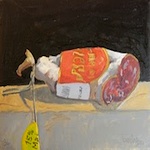As the planet spins off axis in a flurry of bad news I’ve decided to tackle the subject of color.
I wanted to write about Eugéne Chevreul’s influence on the French Impressionists for my Masters in painting. But I never got a M.A. Oh, the shame. But who the hell wants to contract twenty thousands bucks in loans to get a M.A. in painting? Not me. At the time I lived in the U.S.A. and I didn’t know the Eurpoean universities were basically free.
Color in artworks has changed drastically since paeleolithic France. Back then some dude burnt a stick in a fire and drew a horse on the wall of a cave. Dude then colored it in with different colored rocks, kind of like drawing on a chalk board. Amazingly, artists still use charcoal to draw on paper. Others draw on subterranean walls, like Parisian catacombs, but with spray paints.

There are more than 180 paleolithic decorated caves in France. That’s seriously old. France has been through a few wars since then. Even a revolution. I guess there is a reason the government took all the guns away from a bellicose population and now spends money on advancing knowledge in science and the arts.
One of the most important scientists in French history is the chemist Michel-Eugène Chevreul. From the photos of him, let’s say bad hair day didn’t matter.

Among other scientific writings Chevreul penned The Principles of Harmony and Contrast of Colors (and their application to the arts) ©1987 based on the first English edition of 1854 as translated from the first French edtion of 1839. Here is the title in French.
De la loi du contraste simultané des couleurs et de l’assortiment des objets colorés considéré d’après cette loi dans ses rapports avec la peinture, les tapisseries des Gobelins, les tapisseries de Beauvais, pour meubles, les tapis, la mosaïque, les vitraux colorés, l’impression des étoffes, l’imprimerie, l’enluminure, la décoration des édifices, l’habillement et l’horticulture.
In 1992 I wanted this book so badly after I saw it at an artist’s flat in Florence but it wasn’t available in any book stores and Amazon was yet to be invented, so was the internet. My lovely mother knew how to obtain it. She wrote to Shiffler Publishing Ltd. and I sent it across the Atlantic ocean.
M.E. Chevreul revolutionized the use of color. I’ll tell you more about that in the next post.


